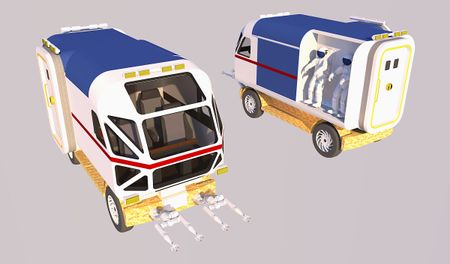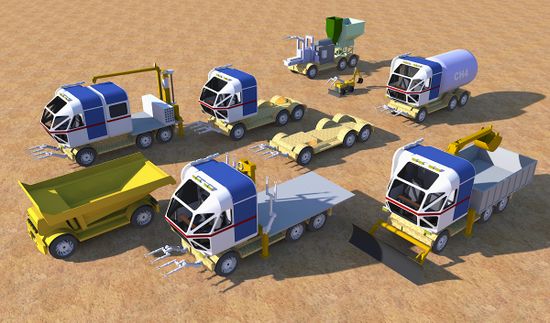Difference between revisions of "Rover"
| Line 1: | Line 1: | ||
The term '''Rover''' as used here describes any all-terrain vehicle designed to traverse the surface of a planet, moon, or asteroid. It allows exploring the surface on a variety of places, collecting and examining [[Minerals]], taking photos. The first rover (''Lunokhod 1'') was unmanned and remote controlled on [[moon|Earth's Moon]] in 1970. During the Apollo missions in the 1970s rovers have been used manned to extend the exploration range of the crew. It was not until 1997 that the first rover landed successfully on [[Mars]]. | The term '''Rover''' as used here describes any all-terrain vehicle designed to traverse the surface of a planet, moon, or asteroid. It allows exploring the surface on a variety of places, collecting and examining [[Minerals]], taking photos. The first rover (''Lunokhod 1'') was unmanned and remote controlled on [[moon|Earth's Moon]] in 1970. During the Apollo missions in the 1970s rovers have been used manned to extend the exploration range of the crew. It was not until 1997 that the first rover landed successfully on [[Mars]]. | ||
| + | |||
| + | A martina settlement would require a number of rovers for [[transportation]], exploration and various construction functions. | ||
==Successful Mars rovers== | ==Successful Mars rovers== | ||
Revision as of 15:27, 29 April 2019
The term Rover as used here describes any all-terrain vehicle designed to traverse the surface of a planet, moon, or asteroid. It allows exploring the surface on a variety of places, collecting and examining Minerals, taking photos. The first rover (Lunokhod 1) was unmanned and remote controlled on Earth's Moon in 1970. During the Apollo missions in the 1970s rovers have been used manned to extend the exploration range of the crew. It was not until 1997 that the first rover landed successfully on Mars.
A martina settlement would require a number of rovers for transportation, exploration and various construction functions.
Contents
Successful Mars rovers
- Sojourner (1997)
- Spirit (2004)
- Opportunity (2004)
- Curiosity (2012)
Planned Mars rovers
- ExoMars is being developed by the ESA and is scheduled for a 2013 launch and 2014 landing.
- The Beaver rover is planned as part of the Canadian Northern Light mission.
Space Exploration Vehicle (SEV)
The SEV is a planned manned rover that was tested by NASA form 2009 to 2013. Full scale prototypes were built and tested. The MMSEV (Multi Mission Space Exploration VEhicle) was a variant that could be used for space missions.
Mars manned rovers
Mars rovers cover a large variety of vehicles that have been developed for mission planning and Science Fiction movies. Most of the designs are close to what the SEV proposes. Rovers could be automated or carry passengers.
A typical specification might call for a pressurized cabin, large windows, external manipulator arms, back entry suits and suit-ports as well as full sized docking ports. Wheels on Mars need to be designed for the very low temperatures. Rubber and most flexible materials available go through a glass transition phase at very low temperatures and become fragile. Wire mesh type wheel, such as those used for the Apollo program Moon Rover might be an applicable solution.
Radiation protection would use water or ice in a double walled hull. Electrical power might come from a 100-200 kWh rechargeable battery back.
A base platform could be modified to provide specialised functions such as a crane, an exploration vehicle, a semi or an ore hauler.








